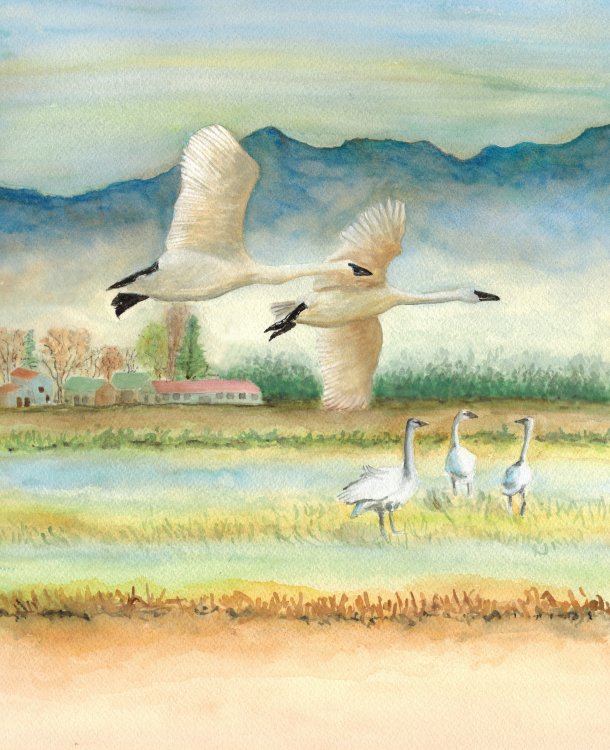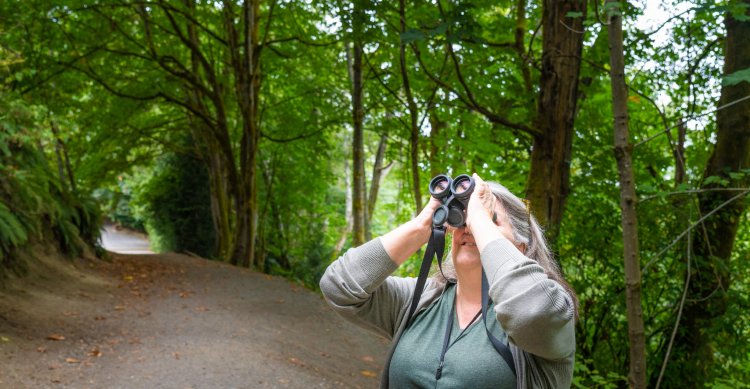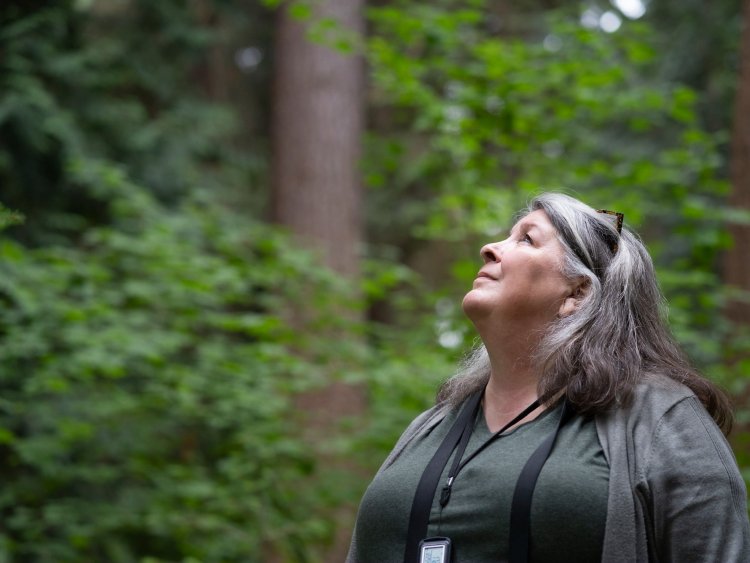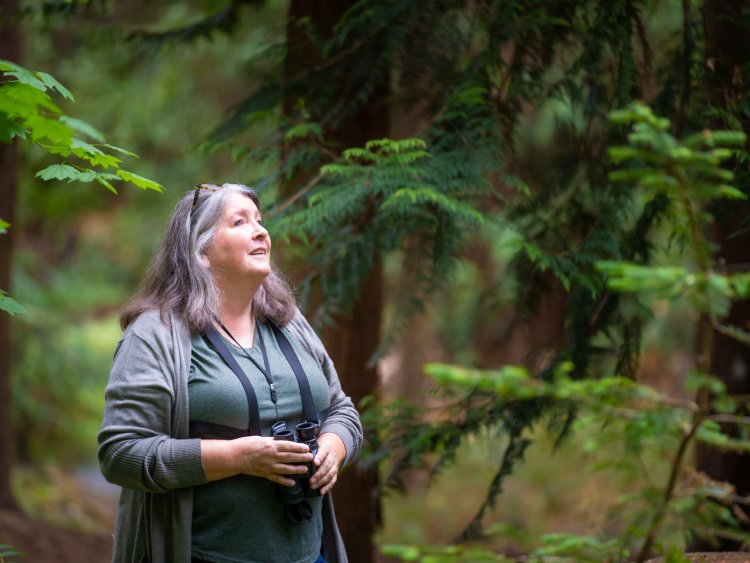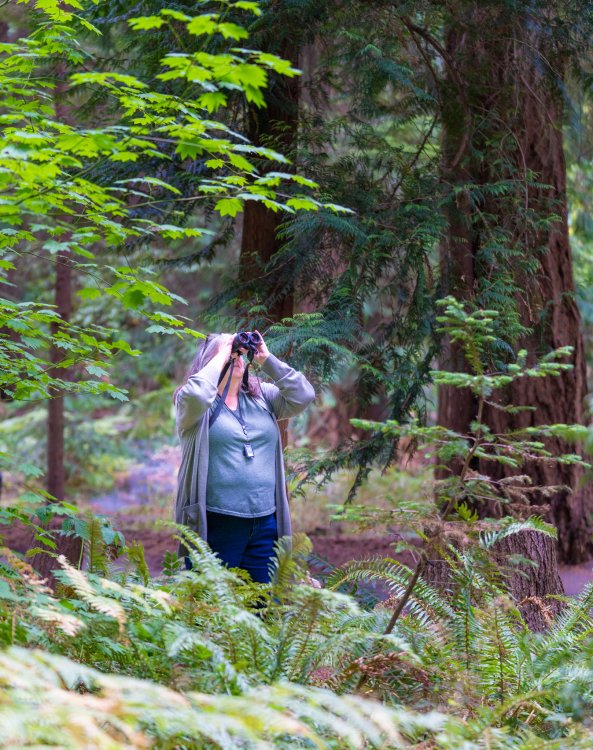“Birders are a funny lot. I’ll be in a park and someone will be like, ‘Oh I just saw a vireo, come on!’ and you just take off with them. It’s like you’re eight years old again. Let’s go play on the slide! It’s awesome.”
“This marsh here — ” Bev Bowe breaks off, an endearing habit of birders always on the lookout. “— Oh! Okay, now, that’s a male, another male, and you’ll see ‘em, and they’ve got…well, there were three here the other day…. In Feb., you’ll see hummingbirds. They do a jay-pop, and you can actually hear the pop. They go way up and then, they shoot down and do a quick up, like a jay, and their wings make a popping sound. That’s a territory thing. Now, let’s go see if we can find a bushtit nest…”
Bowe is a master birder who loves to give newbies a glimpse of paradise, tucked into the hills and marshlands of Edmonds, and beyond. Constantly on alert for the sounds and sights of our fine-feathered friends, she continues an endearing, running commentary about life all around her, whether it’s winter’s first red-tailed hawk sighting or a group of regular birders standing near a grove of bushes, waiting for sparrows to light up the sky.
“Ever heard of something called the Dawn Chorus? Birds at dawn, they get up and if you get up early enough, you can hear them. Everybody gets up and sings their song.”
Bowe’s guided walks are in high demand — the stuff of birding legend. The Puget Sound Bird Fest in Edmonds is lucky to have her.
She’s one of many expert twitchers ready to give you the lay of the land, and sea, at the annual two-day affair, Sept. 10-11, a favorite of amateur and expert birders everywhere.
Bowe leads a Sun. morning guided walk at Yost Park, one of her favorite Edmonds' haunts. The guided walk affords bird’s-eye views of Cooper’s hawks, chickadees, pileated woodpeckers, Pacific wrens, and assorted other resident and migratory birds.
Don’t forget “weird ducks,” plentiful during prime fall season, headed into winter — the best birding season, according to Bowe, because you get a clearer view of the birds up in the tree branches, without all those leaves in the way, or a lot of bright sunshine.
“Eagles are the Mike Tysons of the bird world. They look so big and virile and threatening, and they’ve got this whole, ‘Eee eee!’ In the movies, they always dub in a red-tailed hawk for these birds, because that sounds more manly.”
“September is the very beginning of what we like to call Weird Duck Season, when many seabirds and ducks show up for the winter,” she describes. “There will be shorebirds and some warblers finishing up their southerly migration, too. Two of my favorite winter visitors show up in the wooded parks around here: the varied thrush and the hermit thrush both come down from the higher elevations, where they have been nesting and rearing young and I see both frequently in Yost and Pine Ridge Parks.”
Sign up early for Bowe’s accessible, guided tour, and you’ll be a birder in no time. She has a way of drawing you into their magnificent, hallowed world, an eternal playground, where everyone is welcome and free to be themselves, running around like kids again.
Paradise, really.
“Once you see or hear a new bird singing, you kind of own it.”
After 15 minutes following Bowe around at any one of her tours, you begin to get used to the birding shorthand and the bird-like attention span. The master birder will frequently interrupt her lively, running monologue to notice the slightest flash outside the corner of her eye, or perk up at the sound a certain kind of chickadee makes during mating season.
“Most people [recognize] birds by seeing them,” she explains. “But we find them a lot of times by hearing them. Part of the master birder program is, you are expected to learn birding by ear and you should know a hundred or so. You get tested on it. I was really good at it during class, then I forgot 80 percent of it, which is okay, it’s allowed. It’s birding, not diffusing a bomb [laughs].”
The late Edmonds wildlife photographer Bill [Anderson] “was our buddy, he was our playground playmate.”
Birders are an endlessly curious, ridiculously friendly bunch. Even if they don’t know you, they won’t hesitate to share what they’ve seen and heard, or join in on conversations, as if you’ve always been the best of friends.
Bowe is also given to seamlessly interrupting her ongoing bird commentary to greet fellow birders along any given trail:
“Hello, ladies, lovely day for birding,” she’ll chirp.
“Beautiful morning!” they respond in kind. “Where are you going next?”
“Heading down to the tennis courts. See if we can find some sparrows. You guys see the kinglet?”
“Yes! So exciting. Have a great day, ladies!”
Bird watching and birding are two different animals. One’s a nice hobby, a fun way to pass the time, if so inclined. The other’s serious business, a sport that often compels people to drop whatever they’re doing and fly clear across the country at a moment’s notice just to be there for a rare bird sighting. “They’re the crazy ones,” Bowe jokes.
“I’m actually somewhere in the middle and consider myself both a birder and a bird watcher; it is really a sliding scale, with lots of variations and levels of commitment.”
One of the coolest parts about bird watching is, everyone can play — and nobody judges: old, young, avid, casual, you're all welcome. There are so many different kinds of birders, just as there are birds: loners, social butterflies, seasonal, and year-round. “There are people who bird by scope only, and they will stand on the beach and scope the water, looking to see any kind of seabird they can find, or they stand at the beach and they go to Ocean Shores, and spend hours looking through a scope. And that’s great,” she continues.
All of a sudden, Bowe stops dead in her tracks to warmly greet Wesley, the resident Marsh hummingbird (Anna’s Hummingbird)…a fuzzy green blur hovering and dipping a few feet away — in the middle of an infamous Jay-Pop. “He’s so famous, because he follows people. He recognizes the regulars, too,” she says. “And when our friend, [wildlife photographer] Bill Anderson passed away from cancer [on Feb. 2, 2021], it seemed like Wesley knew somehow…like he was looking for him.”
“You’d be surprised at the birds you do know. You probably know at least 50 to 100. You know crows, you know Canadian goose, you know what a robin is, a song sparrow, a Mallard duck… By the time you’re an adult, you should know about 50 of them.”
Before she has a chance to say more, movement up in the trees dead-ahead attracts her attention and she goes to it like a moth to a flame. She catches adorable Cedar waxwings — fast-moving blips the color of a summer sunset — jumping from branch to branch, before flying off again, and then, turns her head just in time to catch a red-tailed hawk soaring right above her, dangerously close to a murder of territorial crows in a line of trees next to State Route 104.
Just another thrilling day in the life of a master birder, with another eager recruit falling helplessly in love…
The City of Edmonds' Sept. 10-11, 2022 Puget Sound Bird Fest promises lots of fun, informative opportunities to learn more about, appreciate, and celebrate the wonders of our birds and birding community, with stewardship in mind.
Swan biologist Martha Jordan gives a keynote presentation, "Washington’s Swans and Snow Geese: Connections to land use, agriculture, and dairy farms," Sat., 10 a.m., at Edmonds Plaza Room, 650 Main St. The wildlife biologist plans to delve into the wintering habits of Washington's white birds, the Trumpeter and Tundra swans, and snow geese, and the changing farm landscape's effects on their survival.
"...Their presence is intertwined with land use, agriculture crops, and especially dairy farms. As agricultural practices and land use shifts, big changes are expected for the birds, farmers, and visitors who travel to see them each winter. Martha will discuss how farming affects the distribution and population dynamics of these wintering waterfowl in Washington State and beyond, provide an update on issues regarding lead poisoning and other habitat issues, and share photos that help clarify the challenges of identification of Trumpeter and Tundra swans and snow geese. Come learn about these magnificent white birds and what is needed to insure their future [City of Edmonds Puget Sound Bird Fest website]."
The Puget Sound Bird Fest also features workshops, presentations, and demonstrations by local experts, guided nature walks in Edmonds' parks and viewing stations, a "People's Choice" photo contest — adult and junior, boat tours, vendors and booths manned by regional conservation organizations, scientists, and artists, and children's activities, including Sat. Bird Fest Storytime put on by the Edmonds Library and hands-on exploration for the whole family next door at the Frances Anderson Center, with the Bird Fest Exhibits Hall. Many activities are free.
Photography by Matt Hulbert
Winner of the 2022 Bird Fest Poster Art Contest: Janis Howes, "Trumpeter Swans of Skagit Valley Farmlands"
